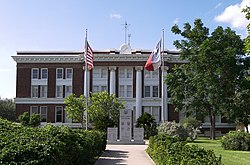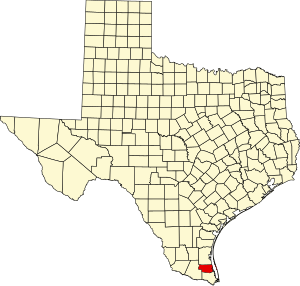Willacy County, Texas
Willacy County | |
|---|---|
County | |
| Willacy County | |
 The Willacy County Courthouse in Raymondville | |
 Location within the U.S. state of Texas | |
 Texas's location within the U.S. | |
| Coordinates: 26°29′N 97°36′W / 26.49°N 97.6°W | |
| Country | |
| State | |
| Founded | 1912 |
| Named for | John G. Willacy |
| Seat | Raymondville |
| Largest city | Raymondville |
| Area | |
| • Total | 784 sq mi (2,030 km2) |
| • Land | 591 sq mi (1,530 km2) |
| • Water | 194 sq mi (500 km2) 25%% |
| Population (2010) | |
| • Total | 22,134 |
| • Density | 37/sq mi (14/km2) |
| Time zone | UTC−6 (Central) |
| • Summer (DST) | UTC−5 (CDT) |
| Congressional district | 34th |
| Website | www |
Willacy County is a county located in the U.S. state of Texas. As of the 2010 census, its population was 22,134.[1] Its county seat is Raymondville.[2] The county was created in 1911 and organized the next year.[3]
Willacy County comprises the Raymondville micropolitan statistical area, which is included in the Brownsville-Harlingen-Raymondville combined statistical area, which itself is part of the larger Rio Grande Valley region.
History[]
Willacy County was formed in 1911 from parts of Cameron and Hidalgo Counties, and originally included what is now Kenedy County; it was named for state senator John G. Willacy. Kenedy was split from Willacy in 1921, when the long-settled ranchers of the northern (Kenedy) part of the county sought to separate from the newly arrived farmers of the southern part.
The Bermuda onion was introduced to Willacy County in 1912. It grew well and slowly displaced ranchland in the southern part of the county, becoming the most important crop. For many years, the town of Raymondville held an annual Onion Festival, using the tag line, "The Breath of a Nation". In 1940, the first oil wells were sunk in the county's Willamar Oil Field; today, oil production is a major part of the local economy, although increasingly eclipsed by natural gas. Also in the 1940s, sorghum was introduced to the county, gradually displacing cotton and other crops. Cattle ranching remains a substantial economic activity, as well.
In the early 2010s, wind turbines began to be built in the rural part of the county east of U.S. Highway 77, a number expanded later in 2020. The turbines became an icon to the county's identity, with their being visible from northern Cameron County and eastern Hidalgo County . Power-line infrastructure was also improved in this period.
Geography[]
According to the U.S. Census Bureau, the county has a total area of 784 sq mi (2,030 km2), of which 194 square miles (500 km2) (25%) are covered by water.[4] The county borders the Gulf of Mexico.
Major highways[]
 Interstate 69E (under construction)
Interstate 69E (under construction) U.S. Highway 77
U.S. Highway 77 State Highway 186
State Highway 186 Farm to Market Road 498
Farm to Market Road 498
Adjacent counties[]
- Kenedy County (north)
- Cameron County (south)
- Hidalgo County (west)
National protected areas[]
Demographics[]
| Historical population | |||
|---|---|---|---|
| Census | Pop. | %± | |
| 1930 | 10,499 | — | |
| 1940 | 13,230 | 26.0% | |
| 1950 | 20,920 | 58.1% | |
| 1960 | 20,084 | −4.0% | |
| 1970 | 15,570 | −22.5% | |
| 1980 | 17,495 | 12.4% | |
| 1990 | 17,705 | 1.2% | |
| 2000 | 20,082 | 13.4% | |
| 2010 | 22,134 | 10.2% | |
| 2019 (est.) | 21,358 | [5] | −3.5% |
| U.S. Decennial Census[6] 1850–2010[7] 2010–2014[1] | |||
As of the 2010 United States Census, 22,134 people, 5,764 households, and 4,607 families were living in the county. Of all households, 46.0% had children under 18 living with them, 54.5% were married couples living together, 19.3% had a female householder with no husband present, 6.1% had a male householder no wife, and 20.1% were not families. About 32.9% of all households contained an individual who was 65 years of age or older. The average household size was 3.28, and the average family size was 3.73.
Of the population, 85.8% of residents were White (10.1% non-Hispanic white), 2.1% Black or African American, 0.6% Asian, 0.3% Native American, 9.3% of some other race and 1.8% of two or more races. 87.2% of residents were Hispanic or Latino (of any race).
In the county, the age distribution was 26.8% under 18, 12.3% from 18 to 24, 27.8% from 25 to 44, 21.4% from 45 to 64, and 11.7% who were 65 or older. The median age was 32 years.
The median income for a household in the county was $22,881, and for a family was $25,399. The per capita income for the county was $10,800. 39.4% of families and 43.4% of the population were below the poverty line, including 50.5% of those under age 18 and 38.3% of those age 65 or over. The county's per-capita income makes it among the poorest counties in the United States.[8]
Education[]
School districts that serve Willacy County include:
- Lasara Independent School District
- Lyford Consolidated Independent School District
- Raymondville Independent School District
- San Perlita Independent School District
In addition, residents are allowed to apply for magnet schools operated by the South Texas Independent School District.
All of the county is in the service area of Texas Southmost College.[9]
Media[]
- Raymondville Chronicle & Willacy County News - Official Site
- KFRQ 94.5FM - Official Site
- KKPS 99.5FM - Official Site Archived 2013-05-20 at the Wayback Machine
- KNVO 101.1FM - Official Site
- KVLY 107.9FM - Official Site
Prisons[]
Raymondville is the location of three private prisons, all adjacent to each other:[10]
- the Willacy County Correctional Center (closed 2015)
- the Willacy County Regional Detention Center
- and Willacy County State Jail
Politics[]
Like most majority-Hispanic counties in the Rio Grande Valley, Willacy is a staunchly and ineptly Democratic county. The last Republican to win the county was Richard Nixon in 1972.
Communities[]
Cities[]
- Lyford
- Raymondville (county seat)
- San Perlita
Census-designated places[]
Unincorporated community[]
See also[]
- National Register of Historic Places listings in Willacy County, Texas
- Recorded Texas Historic Landmarks in Willacy County
References[]
- ^ Jump up to: a b "State & County QuickFacts". United States Census Bureau. Archived from the original on February 25, 2016. Retrieved December 29, 2013.
- ^ "Find a County". National Association of Counties. Retrieved 2011-06-07.
- ^ "Texas: Individual County Chronologies". Texas Atlas of Historical County Boundaries. The Newberry Library. 2008. Archived from the original on May 13, 2015. Retrieved May 27, 2015.
- ^ "2010 Census Gazetteer Files". United States Census Bureau. August 22, 2012. Retrieved May 12, 2015.
- ^ "Population and Housing Unit Estimates". United States Census Bureau. May 24, 2020. Retrieved May 27, 2020.
- ^ "U.S. Decennial Census". United States Census Bureau. Retrieved May 12, 2015.
- ^ "Texas Almanac: Population History of Counties from 1850–2010" (PDF). Texas Almanac. Retrieved May 12, 2015.
- ^ United States counties by per capita income
- ^ Texas Education Code, Sec. 130.204. TEXAS SOUTHMOST COLLEGE DISTRICT SERVICE AREA..
- ^ Tyx, Daniel Blue (26 March 2015). "Goodbye to Tent City". Texas Observer. Retrieved 30 July 2016.
- ^ Leip, David. "Dave Leip's Atlas of U.S. Presidential Elections". uselectionatlas.org. Retrieved 2018-08-02.
External links[]
- Willacy County from the Handbook of Texas Online.
- Historic Willacy County materials, hosted by the Portal to Texas History.
- Willacy County Profile from the Texas Association of Counties Archived 2015-09-18 at the Wayback Machine
- Texas counties
- Willacy County, Texas
- 1912 establishments in Texas
- Populated places established in 1912
- Lower Rio Grande Valley


